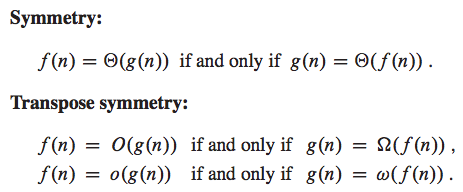3 Growth of Functions
Insertion sort is faster than merge sort at small inputs, but merge-sort is faster at large inputs
Asymptotic _efficiency - concerned with efficiency in the _limit
3.1 Asymptotic Notation
Don't abuse notation
Asymptotic notation, functions, and running times
Asymptotic usually used to describe running time (best, worst, average)
Ø-notation
Ø(g(n)) is set of functions, like f(n), that belong if there exist positive constants c1 and c2 s.t.
it can be "sandwiched" between the c1g(n) and c2g(n) graphs
Ø(g(n)) is a set, where function f(n) is member of the set
To indicate this, use
f(n) = Ø(g(n))
g(n) is an asymptotic tight bound for f(n)

Every function used with Ø notation is asymptotically non-negative
Ignore lower-order terms of asymptotically positive functions when doing tight bounds, and coefficients
Any quadratic function is Ø(n^2), can prove by dividing out n^2 and removing values with limit of 0 as n increases
- Also can do proofs by contradiction
Any constant is a degree-zero polynomial with Ø(1) complexity
O-notation
O-notation gives us the asymptotic Upper Bound, or the worst-case complexity
Ø-notation implies O-notation and Ω-notation
Technically, we are abusing notation
Ω-notation
Ω-notation gives us Lower Bound, or the best-case complexity
- No matter the input size, the running time will at least be a constant * g(n) for large n
Insertion sort is Ω(n), or best-case lower bound, and O(n^2), or worse-case upper bound
However, we can still say
In the Worse-case: Ω(n^2)
In the Best-case: O(n)
Anonymous functions are a way to represent lower-order parts

Trichotomy does not hold for asymptotic notatoin
Ex. sin(n) and cos(n) have no required <, =, or > due to oscillation
3.2 Standard Notations and Common Functions
Monotonicity
Monotonically increasing: $$f(m) \leq f(n)$$
Monotonically decreasing: $$f(m) \geq f(n)$$
Strictly increasing: f(m) < f(n), n is bigger than m
Strictly decreasing: f(m) > f(n)
Floors and Ceilings
Floor of x: Greatest integer $$\leq$$ x, represent by floor(x)
- Monotonically increasing
Ceiling of x: Least integer $$\geq$$ x, represent by ceil(x)
- Monotonically increasing
Modular Arithmetic
a _mod _n is the remainder of the quotient $$a / n$$
- a is equivalent to b, modulo n
Polynomials
Polynomially bounded if f(n) = O(n^k)
Exponentials
Any exponential function with a base strictly greater than 1 grows faster than any polynomial function
Logarithms
Logarithms used here will be base 2, since many algorithms require splitting a problem into 2 parts
Poly-logarithmically bounded if f(n) = O(log^_{k} n)
Polynomials grow faster than any poly-logarithmic functions
Factorials
Stirling's Approximation gives us a weak bound
Functional Iteration
Iterated Log
Fibonacci Numbers
Golden Ratio
Grow Exponentially